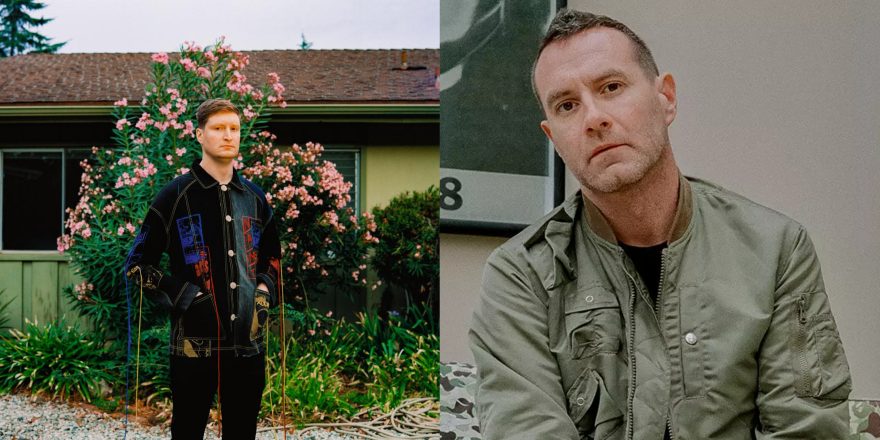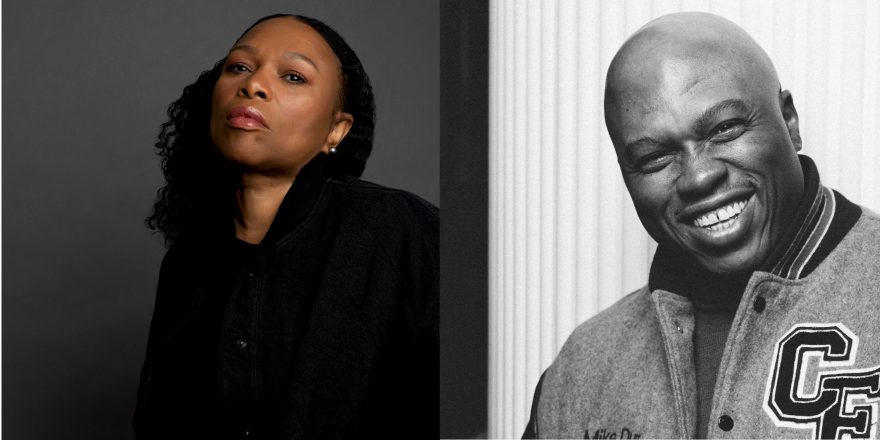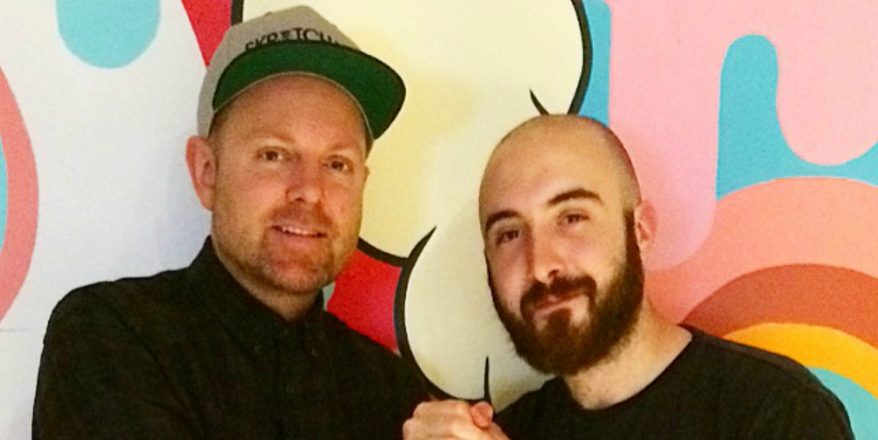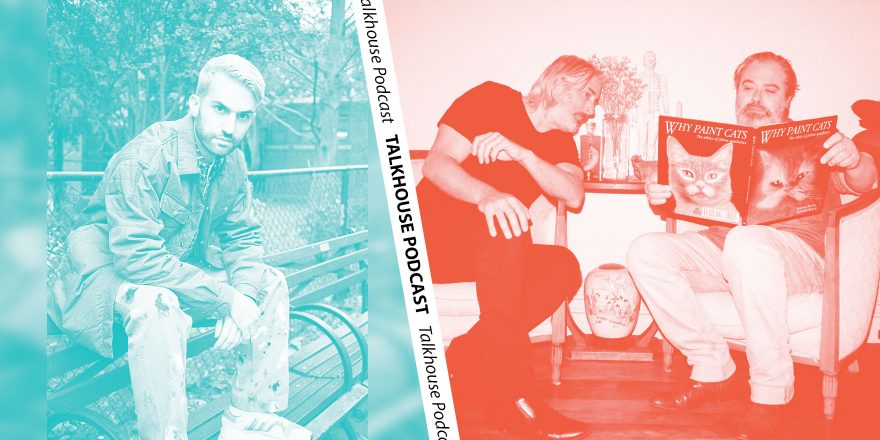Amtrac, aka Caleb Cornett, is an LA-based electronic musician and DJ; James Lavelle is the founding member of the legendary British electronic group UNKLE, and the founder of the record label Mo’Wax. Amtrac just released his latest record, Extra Time, last month (via Openers), so to celebrate, the he hopped on a Zoom call with his musical idol to talk the evolution of electronic music to a mainstream genre, and much more.
— Annie Fell, Editor-in-chief, Talkhouse Music
Amtrac: Hey, James.
James Lavelle: Hey, man. How’s it going?
Amtrac: Not bad. Just been writing music over the long weekend. I haven’t done that in a long time, so it’s nice to get back in the studio. How’ve you been?
James: I’ve been well. I’ve been away, actually. I took the beginning of the year off — I went to South Africa to see my daughter and have some time out and just sort of get refocused, because I had a bit of a difficult year last year with family and stuff. I just got back about a week ago and am sort of getting back into the flow of it, which is good. Feels like definitely a more positive start to this year than it was, unfortunately, last year. So yeah, I’m just trying to get things planned with some shows, and I’ve been working on an exhibition, and sort of spinning plates.
Amtrac: I’m sorry to hear about the family stuff, but it sounds like this year’s been better. I saw you’re doing the party with Bonobo?
James: Yeah. Printworks — this really amazing venue in London where they put on a lot of brilliant electronic artists and DJs — they’re moving out of the space. Because a lot of these places, they get [them] so they can help regenerate the area, and eventually they get built into homes and stuff. So it’s all changing. And there’s this last program, which is pretty phenomenal, of electronic artists until they close, and I think we’re doing one of the last shows there. It’s based around a club that I started when I was 19 with Gilles Peterson called That’s How It Is. It used to be in Piccadilly Circus, right in the center of London, and it was a Monday night and it was just one of the best parties for a long, long time in London. It actually was one of the longest running nights in London, ever, I think — it ran for about 11, 12 years. I stopped playing there probably about six years in, probably around Psyence Fiction, or just after.
But it was an amazing time where Mo’Wax and [Gilles’s label] Talkin’ Loud were really happening, and all these records that we were releasing were getting their place amongst all these other records that we were getting, because we were right at the center of what was happening in this kind of eclectic scene in London at the time. And so it was the first place that a lot of records would get played, especially out of context of their kind of environment. You know, the firs Roni Size Krust records, Goldie’s “Innercity Life” — it would have been one of the first places that got played outside of the drum & bass world. Portishead, Massive Attack, Bjork, what was going on with hip hop, and then records like DJ Shadow — that was the club where all those records were coming together. That’s when I was trying to find my sound as a DJ, and that’s where the Mo’Wax head sound really was developed. Particularly in the early hours of warming up, because you’d play every week and you’d play quite a lot. It would be from 10 ‘til 3 in the morning, so a lot of the time you were wanting to play every week something new, because in that time there was no internet, there was no radio really supporting these records, apart from pirate radio. You had a handful of magazines that might come out once a month where you’d get information. But going to those nights where you heard all the latest records and you saw what was going on with people’s fashion — it was the kind of center of it. It was a pretty amazing time.
So at Printworks, they’re doing a closing series of all these famous club nights that have happened in London.
Amtrac: Mentioning “before the internet” — I pretty much found all of your music through the internet, I think, besides Psyence Fiction. But all the UNKLE sounds, all the mixes and everything that all came from the internet. Because where I grew up, we didn’t really have a record store that carried anything electronic. I grew up in the rural countryside, pretty much.
James: That was the problem in those days. A label like Mo’Wax, you were limited where you could get those records, [outside] of London or Manchester. You had these kind of central cities where the club scenes were happening—
Amtrac: [But] that was still considered a niche genre.
James: Whereas now, it’s a whole different thing. I suppose one of the good things about the internet and digital music is the accessibility is so much greater.
People have kind of crossed over, particularly the sort of countries and how people consume different stuff. Like how America has embraced electronic music more over the years, and vice versa in different places. I’ve been in Africa and it’s amazing to see what’s going on there with their whole house music thing that’s going on, with people like Black Coffee.
Amtrac: Yeah, I think the accessibility is there. Everyone has an opportunity and a shot now.
James: That’s a slightly different conversation, but it’s definitely meant that a wider audience has discovered a lot more. And I think that’s great, because it allows those things to keep growing and to have life, you know? Particularly club culture has become much more of a global thing now.
Amtrac: Yeah. I mean, MTV is how I really accessed any kind of electronic music as a kid, which the only things that broke through to the US really were the bigger, more pop-accessible [artists], like The Prodigy, which crossed over big time here. Chemical Brothers a little bit and Fatboy Slim were probably the peak guys that came through. But then it dug later into, like, Orbital — I watched this program on MTV called Subterranean, which used to play videos at like 1 to 2 AM when everybody was asleep. That was where you could see the more indie, eclectic things. There was a lot of Animal Collective, all the Radiohead videos. But during the day you really wouldn’t see that kind of stuff, unfortunately.
James: I remember, yeah. Did you did you read stuff, like magazines like Urb or any of those kind of things?
Amtrac: I couldn’t really get a hold of anything except for early issues of DJ Mag, when I finally learned what DJing was, to an extent. At first I was just into electronic music and didn’t really know the whole DJ side of it, I was just looking at it from a producer’s standpoint. And then I went to see The Prodigy in Washington, DC, and Adam Freeland opened for, like, two and a half hours and it blew my mind. That was the first time I had seen CDJs. He played everything from Radiohead to some of the craziest deep cuts, and that’s when I kind of fell in love with DJing and saw what it could be. Because until then, it kind of was just a wacky thing.
James: So you were more into hip hop particularly, then, than coming more from an electronic background?
Amtrac: Yeah, definitely. I mean, DJ Shadow and UNKLE and some of the DJ Food stuff I found a little later, when I was digging. But it started with just the bigger name stuff that crossed over, Prodigy being number one, probably, for me growing up. It had a real rebellious tone to it, and was something I resonated with growing up as a skateboarder.
James: Right. For me, I discovered it initially through hip hop, and sort of soundsystem culture here as a kid. At the time, things like Soul II Soul were really happening, and that was really embraced in DJ culture. Before that was being into records, and pretty much the beginning when hip hop first started. And then through that, what happened with acid house and house music, but again, when I first started getting into stuff, it was very limited to what you could see and how you could find it. There was a TV show called Top of the Pops where records that were in the charts, the artists would perform on TV each week. So that’s the first time I saw hip hop and a lot of those early artists coming through. And then there was just more print media to read, because you had magazines DJ and Mix Mag They were much smaller publications, and then you had some hip hop publications.
When I got to London, it was really when everything was starting becoming available because the club culture there was so happening at the time. Suddenly there was this opportunity to go to record stores. But I grew up out of London, like you did, out of a main city, and it was limited. But it was amazing how you did discover these things, and how you kind of grow within that process. I think particularly for me, the difference of not having the internet was this way of finding communities and stuff through record stores — that was a very big thing for me growing up.
Amtrac: Yeah, there was a record store around two hours from me called Ear Ecstasy in Louisville, Kentucky. That was my favorite place to go ever. I would spend so much time in there. They would open CDs for you to listen to they had all these stations of brand new stuff you could open and listen to. I definitely miss that culture of holding the artwork, having tangible things that are kind of lost on people now. I’ve talked to other artists that actually didn’t care about their artwork that much. They were like, “Yeah, it’s just artwork. You throw it up online.” But that to me was something that I took from Mo’Wax that rang so true to what I’m about — you guys really cared about the artwork for all your releases, and everything was so cohesive. That speaks volumes without even having to hear the music. I have the Mo’Wax book and that, for example, is just like a time capsule of a great era that it seems like we’ve moved past a bit, and I don’t agree with that. Spotify doesn’t really celebrate the artwork.
James: It’s very frustrating with the digital platforms. The information that you get is part of what was great, I remember, when you were buying albums. And particularly when I was buying hip hop records, you’d always read on the back the credits and you’d discover who worked on the music, who produced it, and that’s how you might find other people’s records.
Amtrac: And sometimes find samples — sometimes they’d list where the samples are from, which then I’d go down a rabbit hole digging that. Just the art of listening to a record, to holding the artwork while you’re listening to it, is a lost art. Unless you’re really a vinyl collector.
James: I think that is one of the things that is frustrating about the way digital music is consumed. There’s a whole world of people that can work on things, or other elements to it, and you don’t really get that so much. I’ve been working on an art show that I started just before COVID, which we had in Seoul last year, and that’s all about the idea of an album as a complete 3-D sound space — being able to go through all the artwork and experience music in a different way. Because I think you have to kind of create different experiences now, sometimes, for people to really be able to experience music in a more focused way. And we’re all guilty of it. I mean, technology and streaming have a lot great benefits in certain ways. But I think the attention span and the way we consume music and the information, it doesn’t travel in that way anymore, apart from if you’re more into collecting physical products.
So things like that really interest me, where you can create a spatial sound to get people to engage, to let go, to stop and take in the whole environment. Because to me, that’s what music has always been about. It’s not just about sound, it’s about a combination of lots of things.
Amtrac: A hundred percent.
James: I think that a lot of the artists that we revere tend to have that around them. Including contemporary artists — look at somebody like Kendrick Lamar, who to me is really special right now. He’s an amazing artist. There are those considerations going into his work.
Amtrac: It’s definitely not lost — it might just be lost on a lot of the people listening.
James: That’s true.
Amtrac: I feel like the percentage of people that are actually listening to an album start to finish and taking it in as a whole has definitely dropped considerably, compared to how it used to be. People can just skip through Spotify now — “I don’t like this song” — but I’m sure there’s still people listening to the album as a whole, but it’s a lot different.
James: With playlists, you just skip through music in a different way. And I suppose there probably is a relationship when you’ve either paid for something in a different way, or there is a physicality — there’s a different kind of interaction with things, there’s a different value. When I was at the height of DJing vinyl, there was a value to these things, a different kind of value, because you paid for them. Or for work, you had to be the one discovering unique things, and by that, you had to go to different places and get yourself there.
But there are a lot of benefits, as well, to the sense that people can consume and discover things on a much wider scale. There’s a balance of trying to have more information out there, and also how it works financially. I think that’s a big ongoing conversation.
Amtrac: I think as a consumer, it works beautifully, because you have access to everything. But as an artist, it’s maybe oversaturated at times.
James: Yeah. I think we’re definitely in a world that feels right now a little bit like ancient Rome — when you have success now, the level of success that you can achieve if you get that top part is unreal, if you’re a Taylor Swift or a Drake or whatever. In the middle, though, it’s so saturated. There’s so much of it. And that’s the difficulty right now.
Amtrac: Keeping up and just constantly putting out content, making music. It’s hard to set on a record now unless it breaks the charts. You need to come up with more content, you’ve gotta make another album, make more music. It’s just all about numbers these days.
James: It’s also just about the amount of stuff. I find that side of it, at times, can be quite draining. I’m not somebody who’s very involved in social media, particularly, on a personal level, but it has great value to communicating things that you’re doing. But there’s a lot you have to deal with. The way the digital world works, it sort of needs constant content. To me, it’s trying to find a balance with that of also having time to be an artist. To make things in that way, you need to sort of disengage with that at times.
Amtrac: Also growing up, every artist that I admired, there was very few things I could find out about them, unless it was in a published interview with them, maybe in Rolling Stone or some magazine. But now you can really just look into somebody’s life in general, and I don’t really know how I feel about that. The whole idea of being cryptic and secret about how you create, and your career having a little more mystique about it, is something that is probably almost impossible to do nowadays.
James: I think some artists do. Art is one of those things where there are people that touch a lot of people and cut through, and can have that. I mean, Daft Punk is an older example. But Frank Ocean, for instance, isn’t particularly [public]. There are artists like that, but it’s setting that precedent from day one and staying to that, and the audience connecting with it. It’s not easy. It happens to only a few people. And I think now, even if it’s not something where it’s all about your life, it’s just the fact that you have got to create a lot of content.
And it’s so weird how some things you think are going to connect don’t, and some things that you don’t, do. I think you’ve always had that, but back in the day you had a different testing way of doing things. When I was doing Mo’Wax in the early days, you would go and play those records out in clubs and see how they reacted. And if people weren’t particularly into them, you would either not do it or you would change it. I think that created a good filter system for things.
Amtrac: Yeah. I think people still use that to this day too, with putting clips of everything online, it’s just a different context. But definitely I’ve seen a lot of posts where producers will put up three different snippets of something and be like, “Which one do you like the most?” I think Fred Again did a lot of that, but he’s very social on everything. You can see what he’s doing all the time, which I think benefits his work.
James: Yeah. You’re in an album cycle at the moment, right? Because the album just recently came out.
Amtrac: Yeah. It’s being received pretty well. We did four music videos for this one — I was really concentrating on a visual world, as you were talking about earlier. I wanted to bring that to this project. Those have been doing really well, getting great feedback thus far, which I’m excited about. And the tour starts at the top of April, so right now I’m preparing for that and figuring out what I want to take. I’m going to do a live DJ hybrid kind of thing. Some of the rooms I’m playing are strictly clubs, and I’ll probably just DJ there. But a lot of the rooms are proper concert halls with a stage and things, so for those, I’m going to do something a little different.
James: And it’s just you on your own, or will you be doing that with other people?
Amtrac: It’ll be me solo dolo.
James: Cool.
Amtrac: I’m very excited to come to Europe. Hopefully I can meet up with you over there!
James: We’ll do something together in London! We’ll definitely hang out.
Amtrac: Take care, James.
(Photo Credit: right, Chris Tang)







